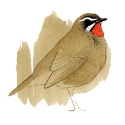OPLOSSING / SOLUTION MYSTERY BIRD 22

De juiste oplossing van ronde 22 is Grote Vale Spotvogel. Van de 23 inzendingen waren er 4 juist (= 17%). Verder werden de volgende soorten genoemd: Oostelijke Vale Spotvogel (12), Westelijke Vale Spotvogel (4), Bosrietzanger (1), Kleine Karekiet (1) en Ménétries‘ Zwartkop (1). Deze Grote Vogel Spotvogel werd op 17 Mei 2012 gefotografeerd door Nicolas Martinez bij Gaziantep, Turkije (37° 9' 43.34; 37° 12'47.02).
The correct answer for round 22 is Upcher’s Warbler. 4 of the 23 answers were correct (= 17%). The following species were also mentioned: Eastern Olivaceous Warbler (12), Western Olivaceous Warbler / Isabelline Warbler (4), Eurasian Marsh Warbler (1), Eurasian Reed Warbler (1), and Ménétries‘ Warbler (1). This picture of Upcher’s Warbler was taken on May 17th, 2012 by Nicolas Martinez near Gaziantep, Turkey (37° 9' 43.34; 37° 12'47.02).
This mystery bird was correctly identified by Davy Bosman, Diederik Kok, Marco Schilz, and Nils van Duivendijk.
There is a single record of a singing (and tape-recorded) Upcher’s Warbler bird from Istanbul on 24th May 1998, which represents the first (and perhaps) only record for geographical Europe (Kirwan et al 2008). Furthermore, Upcher’s Warbler has been recorded in a number of countries that are widely considered to be European countries depending on definition. Upcher’s Warbler occurs in southern Georgia and Georgia is generally considered to be an European country. It also occurs in Azerbaijan, that could also be considered to be an European country. In Azerbaijan Upcher’s Warbler occurs in the very south of the Caucasus according to the distribution given by Birdlife International. However, if the Caucasus is considered to be the geographical border between Europe and Asia, then Upcher’s Warbler does just not occur (breed) in geographical Europe. Upcher’s Warbler has also been recorded on Cyprus in 2002 (A. Corso, Sandgrouse 26, 2004), which is part of ‘political’ Europe. Surprisingly, Upcher’s Warbler has never been recorded on the eastern Greek islands such as Lesbos or Rhodos, and is also not on the official Greek bird list. Though, there is a (unaccepted) report from Upcher’s Warbler from the Island of Chios in 1997 which was then claimed to be the first for Greece (British Birds – The European report 1997). Thus, Upcher’s Warbler has been recorded at least once in geographical Europe (Instanbul) and furthermore in other countries that are widely considered to be European countries.
Some notes about the identification of the mystery bird:
The solution image shows two other pictures of the same Upcher’s Warbler. The picture on the left with the bird posing in the shadow, shows that the bird is an Upcher’s Warbler based on the following features:
i) unequally spaced tertial tips, with the tips of the two longer tertials having the smallest spacing (contra Eastern Olivaceous Warbler);
ii) broad and dark tail (contra Eastern Olivaceous Warbler);
iii) dark brownish wing feathers contrasting with the lighter (greyish) mantle and scapulars (contra Eastern Olivaceous Warbler);
iv) supercilium extending beyond the eye (contra Eastern Olivaceous Warbler & Olive-tree Warbler);
v) clear white wing-panel due to sharply defined white fringes of secondaries (contra Isabelline Warbler, and generally more buffish/diffuse in Eastern Olivaceous Warbler – Harris et al, 1996).
vi) narrow bill (contra Isabelline Warbler).
In the mystery bird picture, some of the abovementioned features are not visible. Due to the early morning light conditions, the upperparts of the bird appear to be rather uniform grey-brown and no contrast between wing and back parts can be seen. Also because of the viewing angle, the spacing between the tertial tips appears to be constant and this is more typical for Eastern Olivaceous Warbler than for Upcher’s Warbler. The primary projection can be well determined and is 68% of the visible length of the longest tertial. The Advanced Bird ID Guide (van Duivendijk, 2010) mentions a primary projection of c. 80% for Upcher’s and c. 70% for Eastern Olivaceous Warbler. Harris et al (1996) mention primary projection of c. 50-66% for (Eastern) Olivaceous and c. 75% for Upcher’s Warbler. However, there is significant overlap in the absolute primary projection length for Upcher’s and Olivaceous Warbler (Shirihai, British Birds 1987): 13-19 mm for Upcher’s and 11-16 mm for (Eastern) OW. It is unclear if the primary projection of the mystery bird is helpful in the identification process. At least, the primary projection is too short for an Olive-tree Warbler.
The head pattern can also not be well judged in the mystery bird and the identification of the mystery may thus be a matter of judgement of posture/proportions and other ‘soft’ features. The forehead appears to be steep, and this is an often-mentioned feature for Upcher’s Warbler. Harris et al (1996) mention that Upcher’s Warbler ‘tends to give heavy-headed appearance recalling large Sylvia-warbler’, as the mystery bird does. Moreover, the bright wing-panel is a well-demarcated rectangular restricted to the secondaries, which is commonly seen on internet pictures of Upcher’s Warbler. In Eastern Olivaceous Warbler the pale panel on the secondaries is often less conspicuous or has poorly demarcated (diffuse) boundaries on internet pictures of this species. (JB)
Ranking after 22 Rounds
Name, score
Andrew Holden 19
Chris Batty 19
Nils van Duivendijk 19
Diederik Kok 18
Dusan Brinkhuizen 18
Lazar Brinkhuizen 18
Davy Bosman 17
Stuart Piner 17
Sietse Bernardus 16
Bas van den Boogaard 15
Hein Prinsen 15
Jos Welbedacht 15
Julien Mazenauer 15
Raf Drijvers 15
Willem Wind 15
Bas van Gennip 14
Fedde Welbedacht 14
Bram Vogels 13
Geir Mobakken 13


